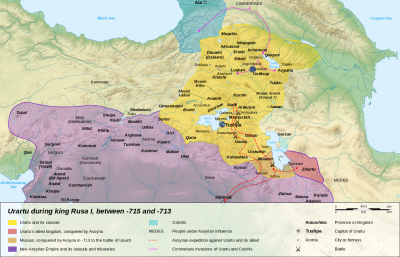“The triangular Muradiye plain, which contains two important Urartian sites, is bounded by the high range on the south-east and by the Açadağ (former Ala Dağ) on the northwest. (…) Despite the alignment of the two main corridors, the medieval trade route from the north of Lake Van to Persia did not run the length of either, but crossed from one to the other. From Muradiye (Berkri) it crossed the hills to the town’s southeast by a pass (maps still show ‘ruins’, no doubt those of hans or villages on the valley, leading to the pass). Thereafter it went to the small plain, where the present town of Dorutay (old Taşrumi, also an Urartian site) is situated.”[1]
In the early 20th, there were 41 towns and villages in the kaza of Pergri (Ar: Berkri; Gr: Barkiri; Ottoman Tr: Bergiri), with a total population of 5,152. Pergri was later downgraded from a kaza to a nahiye. In medieval times, the homonymous Armenian district centre in the northeast of Lake Van was one of the well-fortified strongholds around Lake Van. The town of Pergri was first mentioned in 1035, when the Byzantine Emperor Michael IV conquered the place, which until then had been ruled by islamized Armenians.
During the Armenian genocide, Turks massacred part of its population. Armenian churches were burnt, homes and properties plundered. In 1920, the city was renamed to Bergiri, then in 1932 to Muradiye.
Massacres in the Kaza of Perkri
“According to a survivor from the Berkri/Perkri area, Mushegh Mgrdichian of the village of Yegmal, most of the men of the 41 towns and villages of the kaza of Perkri, (…) had been working in the region’s amele taburis since the August 1914 general mobilization. In early April, gendarmes nevertheless scoured the villages of this kaza, located at the northeastern extremity of Lake Van, in order to ‘mobilize’ all the males over 15, ‘so as to beef up the battalions of worker-soldiers.’ The same informant states that approximately 1,000 men were working in the amele taburis at the time; they were repairing the roads in the Abagha Valley, where the snow was beginning to melt.
On 19 April, these men were massacred in groups of 25 in the narrowest part of the Pante Mahu gorge, which extended to a point ‘two versts’ southwest of Perkri, near the medieval Golod Bridge. Their executioners were gendarmes and militiamen commanded by Milis Iso Telun.
A Kurdish commander of a squadron of hamidiyes, Tahar Beg, had been poisoned at a meal with the kaymakam and the commander of the gendarmerie, Amar Bey, for trying to protect some of these men. On the same day, 80 men were murdered in the village of Khachan (pop. 600), including Usta Mgo, his five brothers, two sons, and several of his nephews.
On the morning of the 19 April, the village of Kordzot (pop. 790), located on the boundary of the nahie of Timar, received a visit from the kaymakam, Ziya Bey, and the commander of the gendarmerie, Amar Bey, accompanied by 200 men and the auxiliary primate, Der [Ter] Manvel.
The villagers scraped up 50 Turkish pounds and ten rifles, in the belief that that would be enough to satisfy the authorities. Eighty-six men were nevertheless arrested and locked up in the Meloyan family home. On the morning of 20 April, the gendarmes set them marching toward Yeghunatsor, where they were all massacred. The neighboring village of Bzdig Kiugh (pop. 447) was occupied on the morning of 20 April by 300 militiamen and hamidiyes under the orders of Süleyman from Irishad (Arjesh); 120 men were arrested in the village and shot in the vicinity, while the village itself was looted and 60 people were slaughtered.
Those who attempted to flee down the road to Perkri were shot as they ran or executed on the Golod Bridge in the Pante Mahu gorge. The next villages to be attacked were Engizag (pop. 311), Surp Tatos (pop. 211), Antsav (pop. 108), and Panz; 60 men from these villages had their throats slit, while the villages were looted and burned down. Some of the inhabitants of these villages found refuge in Kordzot; among them were 50 armed men.
When, on 25 April, Kurdish çetes went to Kordzot to seize its wheat reserves, they were met with heavy gunfire. Doubtless busy wiping out the other villages in the area, Amar Bey and several hundred militiamen waited until 7 May to attack the village. They were met, this time, with spirited resistance that lasted three days. When the Armenian volunteers arrived in the village on 15 May, they were confronted with a morbid spectacle: its central square was strewn with corpses.”
Source: Kévorkian, Raymond: The Armenian Genocide: A Complete History. London, New York: I.B. Tauris, (2011), pp. 323-324; also: https://www.worldhistory.biz/sundries/34215-massacres-in-the-kaza-of-perkri.html
